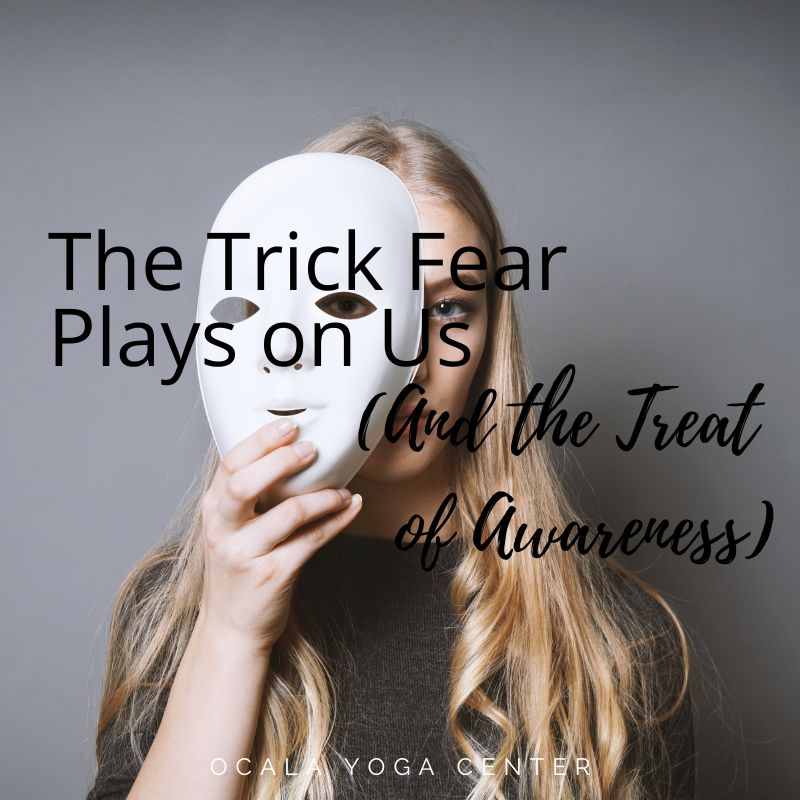The Trick Fear Plays on Us (and the Treat of Awareness)
October is here, and with it comes the season of ghosts, goblins, and things that go bump in the night. Most of us consider Halloween to be a time of playful fun: kids in costumes, candy exchanges, and the thrill of masquerading as someone—or something—else. We laugh at fear, exaggerate the grotesque, and revel in the absurd.
Yet not everyone experiences Halloween that way. Some see the holiday as trivializing evil or even as aligning with forces that should be avoided. This divide—between seeing Halloween as harmless fun or as something sinister—reflects a more profound aspect of human psychology. It points to how differently we respond to cultural traditions, and how often our fears of the “unknown” spill into how we treat people, especially those who seem “Other.”
Fear of the Unknown—Often Beneath Our Awareness
Yoga philosophy teaches that fear is not always visible on the surface. Abhinivesha, described in Yoga Sutra II.9, is the clinging to life and the fear of death that persists even in the wise. This clinging and fear live beneath conscious awareness, driving reactions we may not fully understand. This one sutra shows how ancient yogis understood what modern psychology has confirmed: subconscious processes shape much of our behavior.
Neuroscience and psychology refer to this as implicit bias—the attitudes and associations that operate in the subconscious mind. Studies show that humans tend to perceive people who look, speak, or act differently as less trustworthy or more threatening, even without consciously harboring any prejudice. This subconscious prejudice is a long-standing phenomenon, and it is the nervous system’s way of scanning for potential danger. However, in today’s modern society, it can be dangerously divisive, fueling harmful stereotypes..
This means that the demonization of immigrants, racial minorities, or political opponents isn’t always born of conscious malice. More often, it comes from unexamined fear. A neighbor who looks different, an accent we don’t understand, or a worldview that challenges our own—all can trigger subconscious alarm bells. Left unchecked, this fear hardens into suspicion, and suspicion becomes justification for exclusion, hostility, and violence.
Fear in Politics and Culture
In the United States today, this is playing out vividly. Political rhetoric increasingly paints outsiders as threats: leaders have described immigrants as “invaders,” stereotype racial groups as inherently criminal, and cast those across the political aisle as enemies to be defeated rather than neighbors to understand. The language itself, with words like “enemy,” “invasion,” or “vermin”, taps directly into subconscious fear. It creates monsters out of people, not unlike the costumes we see on Halloween.
The Bhagavad Gita addresses this dynamic directly. In Chapter 16, Krishna distinguishes between divine and demonic qualities. Delusion and separation breed fear, hostility, and intolerance, while compassion, clarity, and courage align with our deeper nature. When fear becomes the driver of political and social life, we are living out the “demonic” qualities Krishna warns against—not because we are evil, but because we are operating from ignorance (avidya) and fear rather than wisdom and connection.
Yoga as a Path of Clarity and Connection
Yoga offers us tools to work with fear, both conscious and subconscious. Sutra I.2 defines yoga as the stilling of the fluctuations of the mind. When the mind is restless, we tend to project fear onto the unknown, but when it is steady, we see things as they truly are.
The yogic path asks us to turn inward and notice our own reactions. That tightening in the chest when encountering someone unfamiliar? That snap judgment about who belongs and who doesn’t? These are the ripples of subconscious fear. Yoga doesn’t ask us to suppress or bypass them, but to bring them into awareness. When we breathe, pause, and observe, we can choose not to be controlled by them.
The Kathopanishad offers wisdom here too, distinguishing between preya (the pleasant) and shreya (the beneficial). Reacting from fear may feel “pleasant” in the sense that it gives us a sense of certainty: we know who the bad guy is, we know who to blame. But the yogic path calls us toward shreya—the beneficial choice that requires courage and compassion, even when it is uncomfortable.
Modern psychology echoes this. Research shows that becoming aware of our biases is the first step to changing them. When we shine the light of awareness (what yogis would call viveka, discernment) on subconscious fears, they lose some of their grip. Awareness creates choice. And choice opens the door to empathy.
From Masks to Humanity
For Halloween, many costumes involve wearing masks. Some are scary, some are silly, but we can see through them all: we know the monster is just a neighbor’s child underneath. The work of yoga, and of a compassionate society, is to extend that same recognition into daily life.
When we peel back the mask of “outsider,” “immigrant,” or “enemy,” what we find is a human being: someone with a family, with joys and struggles, with the same breath of life that animates us all. Demonization dissolves when we see clearly.
The real demons are not the ones on our porches but the ones in our minds—the fear, ignorance, and projections that keep us divided. Halloween invites us to laugh at fear. Yoga invites us to transform it.
Moving Forward
This Halloween season is the perfect opportunity to reflect on some of our unconscious thoughts. We could ask ourselves where we might be projecting fear onto others without realizing it, and if subconscious stories are driving how we see people who seem different. The question yoga invites you to ponder is: How might we use awareness—on the mat, in meditation, in daily life—to create space for compassion instead of division?
The yogic path does not ask us to pretend fear doesn’t exist. It asks us to notice it, understand it, and release its grip so that we can act from love rather than ignorance.
At Ocala Yoga Center, we understand that yoga is a way of life, encompassing much more than simply postures on a mat. A way that resists demonization and embraces compassion. A way that teaches us to see through the masks—both literal and figurative—and remember the unity that was there all along.
So, yes, let’s laugh at the ghosts and goblins this Halloween. But may we also notice the ghosts within: the subconscious fears that haunt our politics, our culture, and our hearts. And may we bring them into the light.
✨ Union, after all, is the true meaning of yoga, perhaps the sweetest treat of all.

